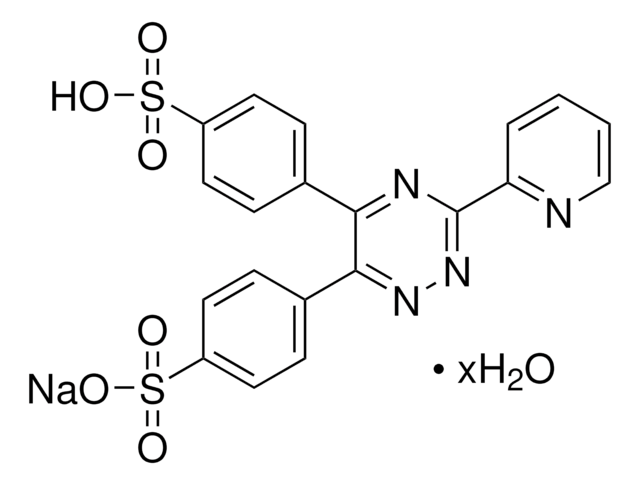P4272
3-(2-Pyridyl)-5,6-di(2-furyl)-1,2,4-triazine-5′,5′′-disulfonic acid disodium salt
Powder or crystals
Synonym(s):
5,5′-[3-(2-Pyridyl)-1,2,4-triazine-5,6-diyl]difuran-2-sulfonic acid disodium salt
About This Item
Recommended Products
product name
3-(2-Pyridyl)-5,6-di(2-furyl)-1,2,4-triazine-5′,5′′-disulfonic acid disodium salt, Suitable for determination of Fe
Quality Level
form
powder or crystals
composition
Water: ≤ 13.0%
Carbon (Theory), anhydrous: 38.87%
Nitrogen (Theory), anhydrous: 11.33%
color
white to dark yellow
solubility
water: 50 mg/mL, clear to slightly hazy
cation traces
C: 38.87% ((Theory), anhydrous)
N: 11.33% ((Theory), anhydrous)
suitability
suitable for determination of iron
application(s)
diagnostic assay manufacturing
hematology
histology
storage temp.
room temp
SMILES string
[Na+].[Na+].[O-]S(=O)(=O)c1ccc(o1)-c2nnc(nc2-c3ccc(o3)S([O-])(=O)=O)-c4ccccn4
InChI
1S/C16H10N4O8S2.2Na/c21-29(22,23)12-6-4-10(27-12)14-15(11-5-7-13(28-11)30(24,25)26)19-20-16(18-14)9-3-1-2-8-17-9;;/h1-8H,(H,21,22,23)(H,24,25,26);;/q;2*+1/p-2
InChI key
IVLSEFOVPQFJBB-UHFFFAOYSA-L
Looking for similar products? Visit Product Comparison Guide
General description
Application
Signal Word
Warning
Hazard Statements
Precautionary Statements
Hazard Classifications
Eye Irrit. 2 - Skin Irrit. 2 - STOT SE 3
Target Organs
Respiratory system
Storage Class Code
11 - Combustible Solids
WGK
WGK 3
Flash Point(F)
Not applicable
Flash Point(C)
Not applicable
Personal Protective Equipment
Choose from one of the most recent versions:
Already Own This Product?
Find documentation for the products that you have recently purchased in the Document Library.
Customers Also Viewed
Our team of scientists has experience in all areas of research including Life Science, Material Science, Chemical Synthesis, Chromatography, Analytical and many others.
Contact Technical Service










